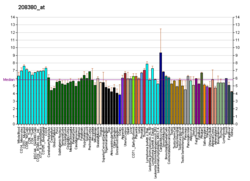Transcription factor LBX1 is a protein that in humans is encoded by the LBX1 gene.
This gene and the orthologous mouse gene were found by their homology to the Drosophila lady bird early and late homeobox genes.
In the mouse, this gene is a key regulator of muscle precursor cell migration and is required for the acquisition of dorsal identities of forelimb muscles.
References
- ^ GRCh38: Ensembl release 89: ENSG00000138136 – Ensembl, May 2017
- ^ GRCm38: Ensembl release 89: ENSMUSG00000025216 – Ensembl, May 2017
- "Human PubMed Reference:". National Center for Biotechnology Information, U.S. National Library of Medicine.
- "Mouse PubMed Reference:". National Center for Biotechnology Information, U.S. National Library of Medicine.
- Jagla K, Dolle P, Mattei MG, Jagla T, Schuhbaur B, Dretzen G, Bellard F, Bellard M (Jul 1996). "Mouse Lbx1 and human LBX1 define a novel mammalian homeobox gene family related to the Drosophila lady bird genes". Mech Dev. 53 (3): 345–56. doi:10.1016/0925-4773(95)00450-5. PMID 8645601. S2CID 19021832.
- ^ "Entrez Gene: LBX1 ladybird homeobox 1".
Further reading
- Gerhard DS, Wagner L, Feingold EA, et al. (2004). "The status, quality, and expansion of the NIH full-length cDNA project: the Mammalian Gene Collection (MGC)". Genome Res. 14 (10B): 2121–7. doi:10.1101/gr.2596504. PMC 528928. PMID 15489334.
- Deloukas P, Earthrowl ME, Grafham DV, et al. (2004). "The DNA sequence and comparative analysis of human chromosome 10". Nature. 429 (6990): 375–81. Bibcode:2004Natur.429..375D. doi:10.1038/nature02462. PMID 15164054.
- de Mollerat XJ, Gurrieri F, Morgan CT, et al. (2004). "A genomic rearrangement resulting in a tandem duplication is associated with split hand-split foot malformation 3 (SHFM3) at 10q24". Hum. Mol. Genet. 12 (16): 1959–71. doi:10.1093/hmg/ddg212. PMID 12913067.
- Strausberg RL, Feingold EA, Grouse LH, et al. (2003). "Generation and initial analysis of more than 15,000 full-length human and mouse cDNA sequences". Proc. Natl. Acad. Sci. U.S.A. 99 (26): 16899–903. Bibcode:2002PNAS...9916899M. doi:10.1073/pnas.242603899. PMC 139241. PMID 12477932.
- Kozmik Z, Holland LZ, Schubert M, et al. (2001). "Characterization of Amphioxus AmphiVent, an evolutionarily conserved marker for chordate ventral mesoderm". Genesis. 29 (4): 172–9. doi:10.1002/gene.1021. PMID 11309850. S2CID 7730828.
- Moretti P, Simmons P, Thomas P, et al. (1994). "Identification of homeobox genes expressed in human haemopoietic progenitor cells". Gene. 144 (2): 213–9. doi:10.1016/0378-1119(94)90380-8. PMID 7518789.
| Transcription factors and intracellular receptors | |||||||||||||||||||||||||||||||
|---|---|---|---|---|---|---|---|---|---|---|---|---|---|---|---|---|---|---|---|---|---|---|---|---|---|---|---|---|---|---|---|
| |||||||||||||||||||||||||||||||
| |||||||||||||||||||||||||||||||
| |||||||||||||||||||||||||||||||
| |||||||||||||||||||||||||||||||
| |||||||||||||||||||||||||||||||
| see also transcription factor/coregulator deficiencies | |||||||||||||||||||||||||||||||
This article on a gene on human chromosome 10 is a stub. You can help Misplaced Pages by expanding it. |




